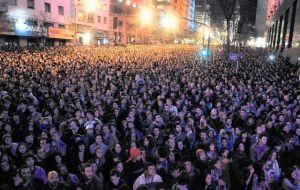MercoPress. South Atlantic News Agency
Uruguay celebrated the bicentennial with a huge colourful popular party
 Thousands gathered in the streeets of Montevideo to sing, dance and watch music and theatre groups
Thousands gathered in the streeets of Montevideo to sing, dance and watch music and theatre groups Uruguay celebrated Monday October 10 the bicentennial of its emancipation process with a great colourful, open party that attracted over 300.000 people to the streets and stages in the capital Montevideo.
Four main stages were displayed in three of the city’s main squares, Plaza Independencia, Plaza Cagancha and in front of the Town Hall plus another next to the Legislative Palace with 23 artists, music and theatre groups taking turns to provide for the thousands, young and old, rich and poor that turned out to celebrate.
Spontaneous dancing and singing broke out and lasted well into the early morning of Tuesday with no major incidents reported, according to police sources.
The show ended with a multicolour display of fire works that lasted over half an hour with a predominance of sky blue, white and yellow, colours which correspond to the country’s national flag.
The party begun with three heavy-rock Argentine groups but later included all kinds of music from reggae to ska , from folklore to Brazilian rhythms impersonated in the world famous Gilberto Gil; from authentic River Plate tango to the music-poetry of Oscar winning Jorge Drexler.
However the prize of the night went to a Spanish group, La Feria dels Baus from Catalonia with a marvellous display of lights, music, dancing, giant figures and hanging structures which occupied most of Plaza Independencia and was a chronicle of Uruguay’s steps to national identity and to independence.
October 10 of 1811 was picked from a long calendar of events because on that day, Jose Artigas was nominated by the (Uruguayan) people Chief of the Orientals (of the river Uruguay, to difference them from the western side currently Argentina).
From then on Artigas led the emancipation of the ‘Orientals’ rejecting Spanish rule and from Buenos Aires which considered itself the capital and heir of the River Place Viceroyalty.
This immediately triggered the dispute of conflicting interests between the port of Buenos Aires and the more accessible and protected Montevideo facilities which last to our days.
Attacked by Buenos Aires Artigas and his people then began an exodus to the north of the country along the river Uruguay from where he started the revolution against Buenos Aires, then Portugal (allied to Buenos Aires), and finally against the Brazilian empire heirs of the Portuguese crown in South America.
All these events helped forge a national identity clearly different to its neighbours and closely linked to the port of Montevideo, opened to world trade and independence ideas of the early XIX century, following on the experience of the United States (1776) and the French Revolution (1789).
Festivities of the emancipation process actually began last February in the city of Mercedes, 300 kilometres west of Montevideo where the first milestone is recorded in Uruguayan national history.
A group of patriots, following on events of May 1810 when Buenos Aires cut loose from Spain as Madrid was taken over by Napoleon forces, solemnly proclaimed to join the independence spirit in the region which meant ignoring the rule of the Spanish viceroy and what was left of that authority.
That was the starting point for a long process of battling against Spain, Buenos Aires, Portugal and Rio do Janeiro and diplomatic efforts with support from Britain that concluded in decisive events of 1825, 1828 and 1830 when the first constitution of the Oriental Republic of Uruguay was sanctioned.
The patriot forces had their first victory in May 1811, when Artigas defeated the Spaniards in the battle of Las Piedras and definitively knocked out the colonial forces.
However since then Uruguayan efforts had to concentrate in fighting and unwinding the conspiracies of Buenos Aires and Rio do Janeiro that never were willing to accept the existence of an independent country in a territory, although minor compared to their vastness, but strategic, which they claimed belonged to them.
Artigas considered the great Uruguayan identity patriot died in exile in Paraguay but one of his lieutenants and brilliant strategist, Fructuoso Rivera would finally convince through the threat of further dismembering the still dispersed neighbours’ national unities to accept the existence of a free independent Uruguay.
Britain, through Lord Ponsonby, emerged at the time as the guarantee of the independence with an obvious interest in having a foothold in the region (buffer state) and promoting free trade through the port of Montevideo.
In a brief speech in national television President Jose Mujica spoke about the personality of Artigas and why October 10 was chosen for the bicentennial celebration.
“This small country has many peculiarities but when we are born we all know that here nobody is above nobody, and Artigas represents much of that, through his actions two centuries ago”, said Mujica.
“It was in a gesture of very primitive democracy that the people on their will and freely choose a political leader because they are going to undertake a major task, the most dramatic of our history”.
I won’t say Artigas forged our national identity, but he does represent us, and the drama of that exodus of the people who followed him, and of the centuries old ports dilemma we have with Buenos Aires”, pointed out Mujica.
“Artigas in bronze is a product of our history, which had to be built it as a common symbol, we needed him”, concluded the Uruguayan president.




Top Comments
Disclaimer & comment rules-

-

Read all commentsCongratulations Yoruguas!
Oct 12th, 2011 - 04:47 am 0@ 1 “Congratulations Yoruguas!” so sweet! Yoruguas! and the yoruguas have been planning for war with Argentina, the great latinamerican brotherhood of the kirchnerists :)
Oct 12th, 2011 - 04:08 pm 0Commenting for this story is now closed.
If you have a Facebook account, become a fan and comment on our Facebook Page!